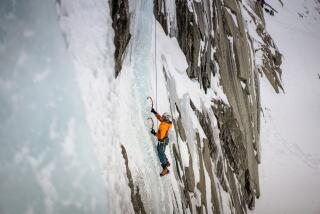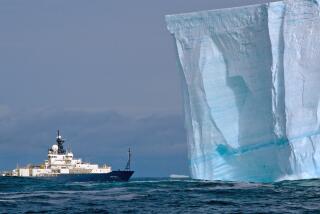ALASKA...AWESOME!
PETERSBURG, Alaska â It sounded like the ultimate macho trip: sea kayaking among the icebergs of Alaska from a wilderness base near a glacier.
But the reality was quite different. It turned out to be one of the most family-friendly trips I had ever experienced, one in which we toured some of the worldâs greatest natural ice sculpture gardens and where bald eagles were as common as crows.
My son-in-law, Franz Lidz, suggested going when he heard that the trip was being offered by Mountain Travel-Sobek, a California tour outfit that specializes in hiking, paddling and climbing throughout the uncivilized world.
Despite the tour companyâs assurances that the six-day Alaskan expedition was suitable for people in reasonably good health, from ages 8 to 80 (even for those with no kayaking experience), persuading most of the rest of the family proved insuperable.
âNo thanks,â said my wife, Jackie. She had humored my outdoorsy wanderlust for the last time when she joined me and the grandkids on a weeklong wagon train across the prairies of North Dakota several years ago.
Franz had no more luck with his spouse, my oldest daughter, Maggie. Since childhood, her idea of roughing it has been to check into an economy-class motel. Their 11-year-old daughter, Gogo, also declined--she had the alternative offer of visiting her Aunt Andi in Paris that week.
But their other daughter, Daisy, 8, was more adventuresome, agreeing to accompany her dad and Grandpop on a flight to the land of the midnight sun. (Actually, we went during the summer solstice last year, and daylight in southeastern Alaska amounted to a mere 17 hours and 50 minutes.)
Our jump-off point was Petersburg, known as âLittle Norway,â a bustling fishing village of 3,300 people on the northern tip of Mitkof Island, between Ketchikan and Juneau. It is one of the many islands along Alaskaâs scenic Inside Passage. Enterprising Norwegian fishermen founded the village at the turn of the century. They looked to LeConte Glacier across Frederick Sound on the mainland as a ready source of slow-melting ice to keep their catch fresh on the trip south to Seattle.
The glacier, too, was our goal, and we were ensconced in a wilderness camp a few miles from it within several hours of our midday arrival in Petersburg via Alaska Airlines.
Our guide, Scott Roberge, met us in a van at the small airport a few minutes from downtown. (Everything in Petersburg is only a few minutes from downtown because most of the 211-square-mile island is a public preserve, limiting expansion.)
We rendezvoused at a hotel, the Scandia House, where we met our traveling companions, a young couple from Minnesota and a father and his teenage son from New Mexico.
Gently spurred by Roberge, all of us decided that some of what we carried was excess baggage to leave behind for our return. The trick was to travel as light as possible, carrying only our sleeping bags, rain gear and light fleece garments we could layer or remove, according to the challenge of changeable weather and our proximity to the chilly ice fields.
We changed into our kayaking gear, which included indispensable knee-high boots, and within two hours were on our way. Five of us traveled to the camp on a jet boat, an hourlong ride, while the father and son went by float plane, a De Havilland with Pratt & Whitney radial engines, work mules of the Northland.
The camp in a quiet cove had been set up in advance by Roberge and his summer assistants, several of them students who are getting degrees in outdoor recreation from Western Washington University.
We staked claim to the two-person tents set on a steep slope in the rain forest. We then set out in the ice-choked water in two-person kayaks for orientation.
Robergeâs basic order was a simple one: Donât fall out. In his 12 years of leading kayaking trips in Alaska, he said he had never had to do what he called a âdeep waterâ rescue.
It was essential advice. He estimated that a person couldnât stay conscious more than two minutes in the frigid, 1,000-feet-deep water. That was true even though the day was sunny and a comfortable 50 degrees, a condition that prevailed for five of our six days. Such good weather was unprecedented in a place that gets more than 100 inches of precipitation a year, Roberge said.
Our kayaks, designed for the sea, were thankfully more stable than the single-person, freshwater versions that tend to be tippy. They were made of fiberglass, were about 21 feet long, weighed 90 pounds and had a rudder controlled with the feet by the person in the rear.
*
Daisy, a precocious young lady possessed of natural physical coordination, took to paddling in Robergeâs kayak as if she were one of the native Tlingits who inhabit the area.
She was the only one to accept Robergeâs challenge to see how long we could keep our hands in the water. She lasted 22 seconds. It would have been longer, she insisted, if the challenge had been more strongly stated. âYou didnât say it was a triple-double-dog dare,â she explained.
Franz and I werenât in a class with Daisy or the guide. We were doing a Titanic tango, smacking into virtually every boulder-size iceberg calved from the glacier that came into our path.
âHey, you guys, these kayaks arenât indestructible,â Roberge had to admonish us more than once.
We dared not venture near the giant bergs, some as big as houses. They frequently shifted and broke apart under the warming sun, sounding like thunder, booming cannonades and shotgun blasts.
We also heard noise that sounded like rifle shots, and it turned out thatâs what they were. Roberge told us the Indians across the bay were evidently exercising their rights to harvest the harbor seals that abounded in the region.
The seals added to the cacophony as they barked and honked in alarm to their pups and one another. Many of them, oxymoronically, lay sunning on the icebergs, a safe haven from preying sea lions, though not from the natives.
*
By the end of the first evening, sitting around the campfire, we were all confident that we were up to the next dayâs journey into LeConte Bay. Our goal was to get as close as possible to LeConte Glacier, the southernmost active tidewater glacier in the Northern Hemisphere. It oozed off the Coastal Mountains separating the United States from Canada and spawned the summertime icebergs in our path.
But we never got near it. We paddled leisurely for about three hours through a growing complex of neon-blue ice sculptures that would do a museum of modern art proud. But an almost solid field of ice stopped us dead at a spot appropriately named Thunder Point. The glacier lay about two miles away around a bend in the bay.
Before turning back, we went ashore to lunch on cheeses, fruit, peanut butter, tuna, cold salmon, bagels and gorp (gobs of raisins and peanuts) at an inlet where freshwater Bussy Creek flowed into the bay.
*
The next day, after we had a morning cruise in our kayaks, the jet boat showed up to transfer us to two seaplanes that landed outside the ice zone. They would take us to a new camp on an ice-free part of Frederick Sound to look for humpback whales.
But, at our request, the planes soared up the bay and through a canyon over LeConte Glacier. The glacier was a spectacular mass many hundreds of feet deep that gave me new appreciation for how the prairies of the Dakotas, the hills of the Midwest and the Finger Lakes of New York were carved during the retreating Ice Age.
At Big Creek on Kupreanof Island, we were disappointed that the humpback whales that come from Hawaii to spawn every June had not yet arrived. But as if to allay our disappointment, teams of curious sea lions kept popping up to gambol near our kayaks.
Dozens of bald eagles staked out the boulders and trees as sentinels near our campsite while they took turns feeding on a dead seal washed up on the beach. The oldest and strongest of our national symbol got first dibs on the carcass.
Pacific loons, wrens, greater yellow legs, chestnut-backed chickadees and more exotic species gave the bird-watchers among us some new entries in their bird books.
Black flies abounded on the sunny beaches, and Franz had the bad luck to be bitten by a particularly nasty variant called a âwhite socksâ the first day. His right hand swelled to the size of a catcherâs mitt. It itched more than hurt, but it didnât stop him from using the paddle. It wasnât back to normal until the last day.
Daisy, who had a bout of Bellâs palsy brought on by Lyme disease she had contracted a couple of years earlier, appreciated the lack of ticks in Alaska, unlike the woods that surround herin Pennsylvania home.
Her good cheer held up throughout the trip, making her the center of attention and a good sport who could take a ribbing and give one as good as she got.
She also mastered more than how to handle a paddle on our trip. A few days after we arrived home, I got a call from her mother.
âDaisy said she learned a lot of new swear words from Grandpop,â Maggie said, her voice oozing icy disapproval. Presumably Daisy had been listening intently when Franz and I were bumping into those icebergs. It was almost enough to make me rethink family trips with the grandkids.
(BEGIN TEXT OF INFOBOX / INFOGRAPHIC)
GUIDEBOOK
Paddling Alaska
Getting there: Alaska Airlines has flights to Petersburg, involving a change of planes in both Seattle and Juneau. Restricted, advance purchase round-trip fare starts at $506.
Kayaking expeditions: Mountain Travel-Sobek (6420 Fairmount Ave., El Cerrito, CA 94530-3606; telephone [510] 527-8100, fax [510] 525-7710) offers several five-day Inside Passage sea kayak tours this summer. Each guide-led trip accommodates from five to 20 members; prices begin at $1,349 per person, including meals and equipment but excluding air fare.
Tongass Kayak Adventures (P.O. Box 787, Petersburg, AK 99833; tel. [907] 772-4600, fax [907] 772-3940) offers several guided sea kayaking trips in the area, from day trips to eight-night Explorer Tours to women-only trips. A three-night wilderness-base adventure, for example, is $550 per person, equipment and food included, air fare extra.
For more information: Alaska Division of Tourism, P.O. Box 110801, Juneau, AK 99811-0801; tel. (907) 465-2010.
More to Read
Sign up for The Wild
Weâll help you find the best places to hike, bike and run, as well as the perfect silent spots for meditation and yoga.
You may occasionally receive promotional content from the Los Angeles Times.






